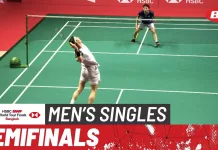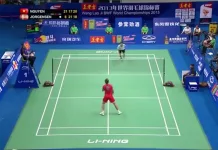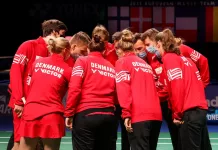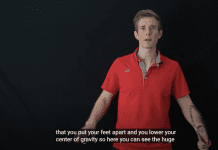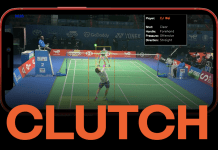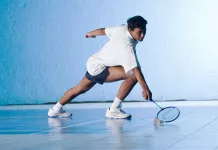
Badminton players and experts often claim that badminton is much harder to master than tennis. Studies have proven that badminton is a faster sport and a more physically demanding game than tennis.
But is it really, and how so?
The following is largely based on the opinions of Sean Yiu which we have edited for your enjoyment.
Badminton vs. tennis differences for newbies
Fast fact: badminton can be enjoyed without any prior experience whatsoever. Tennis takes longer.
Compared to tennis, badminton is much easier to pick up for a beginner.
For example, two beginners playing badminton in the garden standing, say, 3 meters (10 feet) from each other with a badminton net in between can start playing immediately. Simply by hitting up and at an angle at the shuttle for it to fly to the other person’s side of the court.
A rally of 5-10 continuous shots back and forth for extreme beginners would not be too difficult to attain. Quickly beginners will achieve longer rallies as long as they aren’t putting too much pressure on each other.
On the other hand, tennis for two beginners would find it relatively difficult to hit a tennis ball across the net at the right trajectory and with sufficient speed that allows the opposing player to hit it back to make it a meaningful rally. Good luck if the rally lasts more than a few shots on either side.
Of course, tennis has the advantage of being played on many different surfaces indoors and outdoors. Badminton has developed air-badminton as a structured method to play and compete outdoors on different surfaces.
Badminton aerobics vs tennis aerobics
Badminton is relatively higher in aerobic requirements as the movement needed is more “3 dimensional”.
This is due to the angles that the shuttle takes in flight. Hitting the court requires movement to roughly six points of the court at the knee or lower level, standing level, or high overhead levels.
In tennis, a baseliner style would be hitting behind the baseline much like a ping-pong player would be playing at the end of the table. The movement would be more side to side and sometimes to move forward on short balls to finish the rally. A serve and volleyer would be more 3D in court coverage as he/she would rush to the net and finish off the rally with angled volleys.
Badminton vs. tennis speed
I do not believe that badminton is an inherently faster sport. It does require very fast movement – defending against smashes, taking the shuttle early at the net to gain strategic advantage, moving to the 4 corners of the court, etc but to excel in tennis requires fast movement too.
One has to be very quick to volley or backpedal to cover the ground for an overhead smash. Returning serve against slice requires very fast movement to cut to intercept services coming in at extreme angles. Having said that, badminton requires fast, bursty movement almost all the time during a rally while tennis players’ movements are relatively slower on baseline rallies and increase as the player gets closer to the net.
Core strength required tennis vs. badminton
Core strength in Badminton and Tennis is important, but I would give the edge to Badminton as the turning and twisting in 3D is key. As to upper body strength, Tennis has the edge in requirements as the racket and ball are heavier and overwhelming raw service speeds and straight-out groundstroke winners are key advantages to win a point.
Precision requirements in tennis and badminton
Badminton requires relatively higher precision than Tennis. All things being equal, the Badminton court is much smaller than a Tennis court. In Badminton, to gain an advantage over the opponent, one has to be able to direct the shuttle to one intended spot which is just out of reach of the opponent – this requires great precision. In badminton lingo, it’s called Placement.
Also, other than smashes, the shuttle travels slower in flight (and it decelerates faster with distance due to shuttle mechanics) so the opponent can recover ground easier than in Tennis. Tennis precision is important also – e.g. groundstrokes to pin the opponent back and straight winners and angled volleys.
Differences in technique and skills – tennis vs. badminton
The skill requirements at the advanced level are high for Badminton and Tennis but they are different in nature. For example, Badminton requires mastering full smash, half smash, reverse smash, slice drop, reverse drop, clear, push clear, backhand to the net, backhand clear to back, serve and serve return, net play forward, net play cross court, smash defense to the body, left and right.
Tennis requires mastering flat serve, slice serve, reverse serve, and American twist serve. Volleys can be straight or angled volleys or half volleys. Forehands can be flat or topspin straight, inside out, cross court, or looping over opponents who are at the net. Backhands can be sliced, topspin, outside in, straight, or cross-court.
Returning serves is about intercepting the ball at the tightest angle to the ball and with forward motion. Badminton is more “wristy” – the arm motion begins with big muscles and requires the motion to end at the wrist and in some shots even to the end of the fingers.
Tennis requires the arm to be relatively in a free-flowing fluid motion. However, to say Tennis does not require wrist action would be over-generalizing as heavy top spinners are “wristy” as well.
In one area of skill – anticipation and deceptiveness – I would say advanced Badminton has relatively higher requirements than advanced Tennis. Again, because the court is smaller and the game is played in full 3D, anticipation of where your opponent is hitting the shuttle is a major advantage.
On the flip side, countering your opponent’s anticipation by deceptive movements of the head, body, arm, and wrist motion is equally key. In Tennis, anticipation, and deceptiveness are required too – mainly by cues from body orientation and racket face – but these are relatively less critical compared to other aspects of the game.
Tactical differences between badminton and tennis
Playing advanced Badminton and Tennis requires employing good tactics. In badminton, a player employs the full court in 3D to outmaneuver the opponent. Change of pace, placement, deceptiveness, anticipating angles, and even employing high straight clears where appropriate are key. In Tennis, the tactics are built in a more 2-D kind of way.
For example, baseline strokes are to keep the opponent at the backline and usually to the opponent’s backhand side. A slice serve to the Deuce court (an opponent who is a right-hander) opens up the court for a volley winner cross court. Topspins are employed to reduce the margin of error and make the opponent hit higher and further behind the court. Flat baselines keep the pace fast and maximize the angle of attack.
Undeniable facts about tennis compared to badminton
The enjoyment of a sport is a matter of personal opinion. The question of which sport is better, is therefore highly subjective.
But one fact is undeniable: professional tennis players make a whole lot more money than badminton players do. It has been that way forever, and, likely, it won’t change anytime soon.
Similarly, tennis is considered more prestigious than badminton in many countries. Tennis also attracts much bigger audiences at the professional level than badminton.
Summary:
Badminton is easier than Tennis for beginners to pick up. At more advanced levels, Tennis and Badminton are just as “hard” but in different areas.
- What is a shuttlecock? - June 20, 2024
- Which shuttlecock should I use? - June 18, 2024
- Annie Xu and her identical twin sister’s unique Olympic qualification journey - June 1, 2024






